spring-boot-learning-配置文件相关

<!-- https://mvnrepository.com/artifact/org.springframework.boot/spring-boot-configuration-processor -->
<dependency>
<groupId>org.springframework.boot</groupId>
<artifactId>spring-boot-configuration-processor</artifactId>
<version>2.3.2.RELEASE</version>
</dependency>
•application.yml
配置文件的作用:修改SpringBoot自动配置的默认值;SpringBoot在底层都给我们自动配置好;
YML文件的语法:
server:
port: 8081
<server>
<port>8081</port>
</server>
yaml基本的语法:
k:(空格)v:表示一对键值对(空格必须有);
以空格的缩进来控制层级关系;
只要是左对齐的一列数据,都是同一个层级的
注意:属性和值也是大小写敏感;
server:
port: 8080
error:
path: /error
值的写法:
字面量:普通的数,布尔值,字符串
字面直接来写;
字符串默认不用加上单引号或者双引号;
"":双引号===不会转义字符串里面的特殊字符; 特殊字符会作为本身想表示的意思
name: "zhangsan \n lisi"
输出;zhangsan 换行 lisi '':单引号===会转义特殊字符,特殊字符最终只是一个普通的字符串数据
name: ‘zhangsan \n lisi’
输出;zhangsan \n lisi
user:
name: quan
age: 20
就是user.name = quan
user.age = 20
注意:在下一行来写对象的属性和值的关系;注意缩进
用-来表示数组或者集合的元素:
names:
- quan
- zhi
- qiang
上面表达的就是
names[quan,zhi,qiang]
配置文件的注入方式
@ConfigurationProperties 定义类中的属性和配置文件的那些配置相关prefix指定前缀
@Component 将组建加入都容器当中
/**
* 将配置文件中配置的每一个属性的值,映射到这个组件中
* @ConfigurationProperties:告诉SpringBoot将本类中的所有属性和配置文件中相关的配置进行绑定;
默认在全局配置文件中获取值的
* prefix = "person":配置文件中哪个下面的所有属性进行一一映射
*
* 只有这个组件是容器中的组件,才能容器提供的@ConfigurationProperties功能;
@Component
* */
配置文件内容:

person:
lastName: hello
age: 18
boss: false
birth: 2017/12/12
maps: {k1: v1,k2: 12}
lists:
- lisi
- zhaoliu

映射:
@Component
@ConfigurationProperties(prefix = "person")
public class QuanTestConfig {
private String lastName;
private Integer age;
private Boolean boss;
private Date birth; private Map<String, Object> maps;
private List<Object> lists; public String getLastName() {
return lastName;
} public void setLastName(String lastName) {
this.lastName = lastName;
} public Integer getAge() {
return age;
} public void setAge(Integer age) {
this.age = age;
} public Boolean getBoss() {
return boss;
} public void setBoss(Boolean boss) {
this.boss = boss;
} public Date getBirth() {
return birth;
} public void setBirth(Date birth) {
this.birth = birth;
} public Map<String, Object> getMaps() {
return maps;
} public void setMaps(Map<String, Object> maps) {
this.maps = maps;
} public List<Object> getLists() {
return lists;
} public void setLists(List<Object> lists) {
this.lists = lists;
} @Override
public String toString() {
return "QuanTestConfig{" +
"lastName='" + lastName + '\'' +
", age=" + age +
", boss=" + boss +
", birth=" + birth +
", maps=" + maps +
", lists=" + lists +
'}';
}
}
这里类的属性名字需要和配置文件里面的变量名字一样
test:
@SpringBootTest
class HuolalaApplicationTests {
@Autowired
QuanTestConfig quanTestConfig; @Test
public void setQua(){
System.out.println(quanTestConfig);
}
}
结果:
QuanTestConfig{lastName='hello', age=18, boss=false, birth=Tue Dec 12 00:00:00 CST 2017, maps={k1=v1, k2=12}, lists=[lisi, zhaoliu]}
注意:可以导入配置文件处理器,以后编写配置就有提示了
<dependency>
<groupId>org.springframework.boot</groupId>
<artifactId>spring-boot-configuration-processor</artifactId>
<version>2.2.6.RELEASE</version>
</dependency>
除了使用 @ConfigurationProperties进行配置值获取
之前使用bean标签添加到容器中的时候,对应现在的就是@Component
value标签对应的就是现在注解@Value
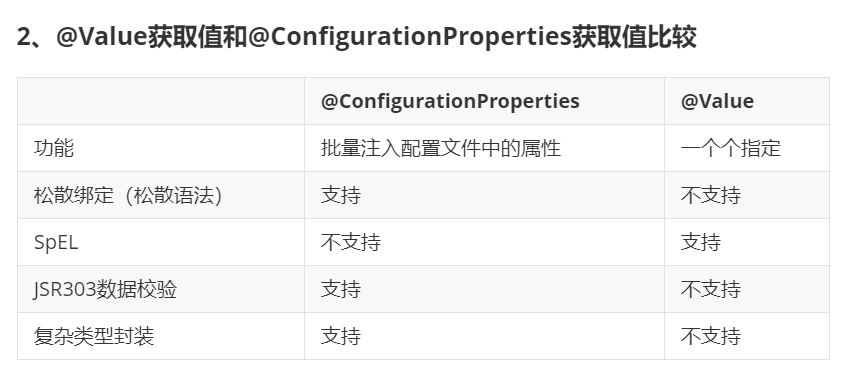
什么是松散语法:

@Value 和@ConfigurationProperties的区别是什么
配置文件yml还是properties他们都能获取到值; 如果说,我们只是在某个业务逻辑中需要获取一下配置文件中的某项值,使用@Value;
如果说,我们专门编写了一个javaBean来和配置文件进行映射,我们就直接使用@ConfigurationProperties

@Component
@Validated//表示里面的value需要进行JSR303数据校验,就是下面的@Email
public class Person { /**
* <bean class="Person">
* <property name="lastName" value="字面量/${key}从环境变量、配置文件中获取值/#{SpEL}"></property>
* <bean/>
*/ //lastName必须是邮箱格式
//@Value("${person.last-name}")
private String lastName;
//@Value("#{11*2}")
private Integer age;
//@Value("true")
private Boolean boss; private Date birth;
private Map<String,Object> maps;
private List<Object> lists;
private Dog dog;

上面就是配置文件注入的数据校验
关于数据校验:
什么是数据校验
数据校验就是在应用程序中,对输入进来得数据做语义分析判断,阻挡不符合规则得数据,放行符合规则得数据
一种是 Spring 自带的验证框架
一种是利用 JSR 实现。JSR 是一个规范,提供了完整得一套 API,通过标注给对象属性添加约束,例如Hibernate Validator
<dependency>
<groupId>org.hibernate.validator</groupId>
<artifactId>hibernate-validator</artifactId>
<version>6.1.0.Final</version>
</dependency>
Hibernate Validator 定义的校验包括:
注解 作用目标 检查规则
@Length(min=, max=) 属性(String) 检查字符串长度是否符合范围
@Max(value=) 属性(以 numeric 或者 string 类型来表示一个数字) 检查值是否小于或等于最大值
@Min(value=) 属性(以 numeric 或者 string 类型来表示一个数字) 检查值是否大于或等于最小值
@NotNull 属性 检查值是否非空(not null)
@Future 属性(date 或 calendar) 检查日期是否是未来
@Pattern(regex="regexp", flag=) 属性(string) 检查属性是否与给定匹配标志的正则表达式相匹配
@Range(min=, max=) 属性(以 numeric 或者 string 类型来表示一个数字) 检查值是否在最小和最大值之间(包括临界值)
@Size(min=, max=) 属性(array,collection,map) 检查元素大小是否在最小和最大值之间(包括临界值)
@AssertFalse 属性 检查方法的演算结果是否为 false(对以代码方式而不是注解表示的约束很有用)
@AssertTrue 属性 检查方法的演算结果是否为 true(对以代码方式而不是注解表示的约束很有用)
@Valid 属性(object) 对关联对象递归进行验证。如果对象是集合或数组,就递归地验证其元素;如果对象是 Map,则递归验证其值元素
@Email 属性(String) 检查字符串是否符合有效的 email 地址规范
@Past 属性(date 或 calendar) 检查日期是否是过去
@PropertySource& @ImportResource& @Bean三个注解
当我们将所有配置都配置到一个文件application.properties,显然这个文件太多内容,所以我们
可能会使用新的属性文件,例如数据库的配置可以在jdbc.properties中,加入下面注解指定就行。
@PropertySource加载指定的配置文件;
例子:
@PropertySource(value = {"classpath:person.properties"})//classpath表示的是main路径下的,就是类路径下的。
@Component
@ConfigurationProperties(prefix = "person")
//@Validated
public class Person {
。。。。。。
@PropertySource(value = {"classpath:jdbc.properties"},ignoreResourceNotFound = true)
igoreResourceNotFound可以忽略找不到配置文件,不报错
@ImportResource:导入Spring的配置文件,让配置文件里面的内容生效;
Spring Boot里面没有Spring的配置文件,我们自己编写的配置文件,也不能自动识别;
想让Spring的配置文件生效,加载进来;@ImportResource标注在一个配置类上
@ImportResource(locations = {"classpath:beans.xml"})
导入Spring的配置文件让其生效
以前我们每加入一个bean则需要编写spring配置文件:即bean的配置文件

<?xml version="1.0" encoding="UTF-8"?>
<beans xmlns="http://www.springframework.org/schema/beans"
xmlns:xsi="http://www.w3.org/2001/XMLSchema-instance"
xsi:schemaLocation="http://www.springframework.org/schema/beans http://www.springframework.org/schema/beans/spring-beans.xsd">
<bean id="helloService" class="com.atguigu.springboot.service.HelloService"></bean>
</beans>

现在:
SpringBoot推荐给容器中添加组件的方式;推荐使用全注解的方式
1、@Configuration放在配置类------>等同于我们之前的Spring配置文件
2、使用@Bean给容器中添加组件

/**
* @Configuration:指明当前类是一个配置类;就是来替代之前的Spring配置文件
*
* 在配置文件中用<bean><bean/>标签添加组件
*
*/
@Configuration
public class MyAppConfig { //将一个类的实例返回值添加到容器中;容器中这个组件默认的id就是方法名
//下面就是加入bean HelloService ,并且id为helloService02
@Bean
public HelloService helloService02(){
System.out.println("配置类@Bean给容器中添加组件了...");
return new HelloService();
}
}

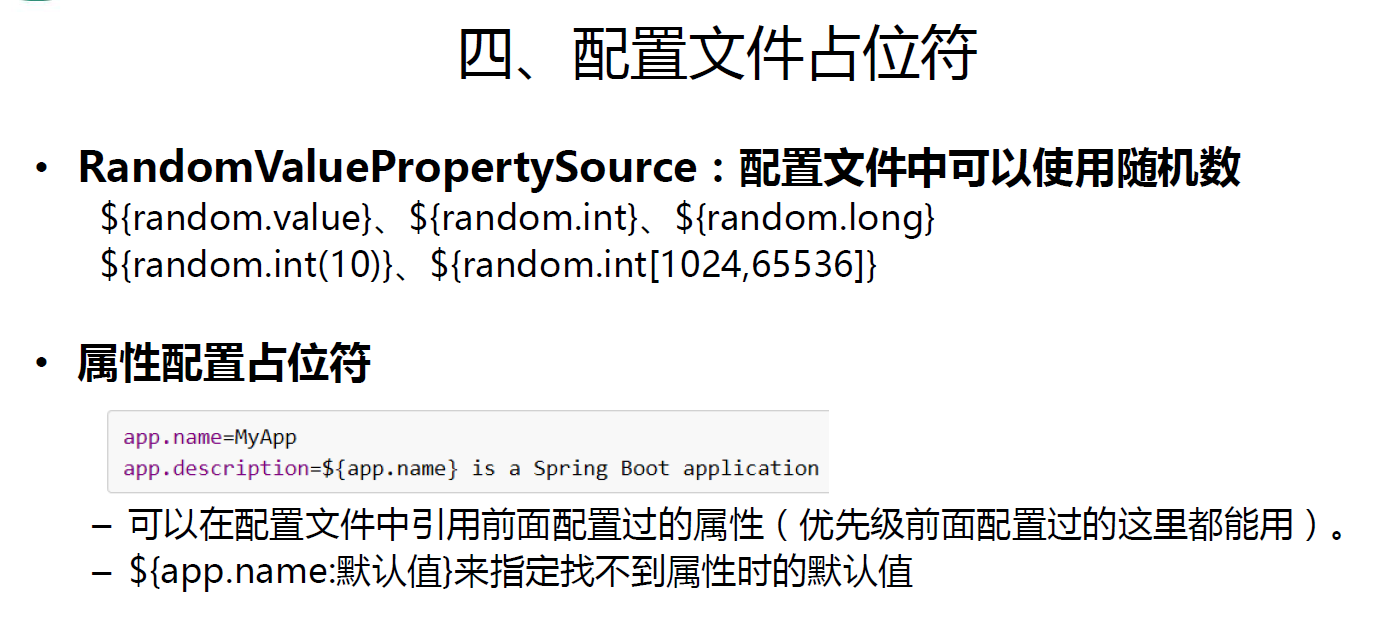
使用占位符的时候是可以设置好默认值的:如果没有可以是用:指定默认值
多Profile文件
我们在主配置文件编写的时候,文件名可以是 application-{profile}.properties/yml
默认使用application.properties的配置;

编写不同环境的配置文件:
application-dev.properties 在默认的全局配置文件当中
即application.properties中配置:
在配置文件中指定 spring.profiles.active=dev

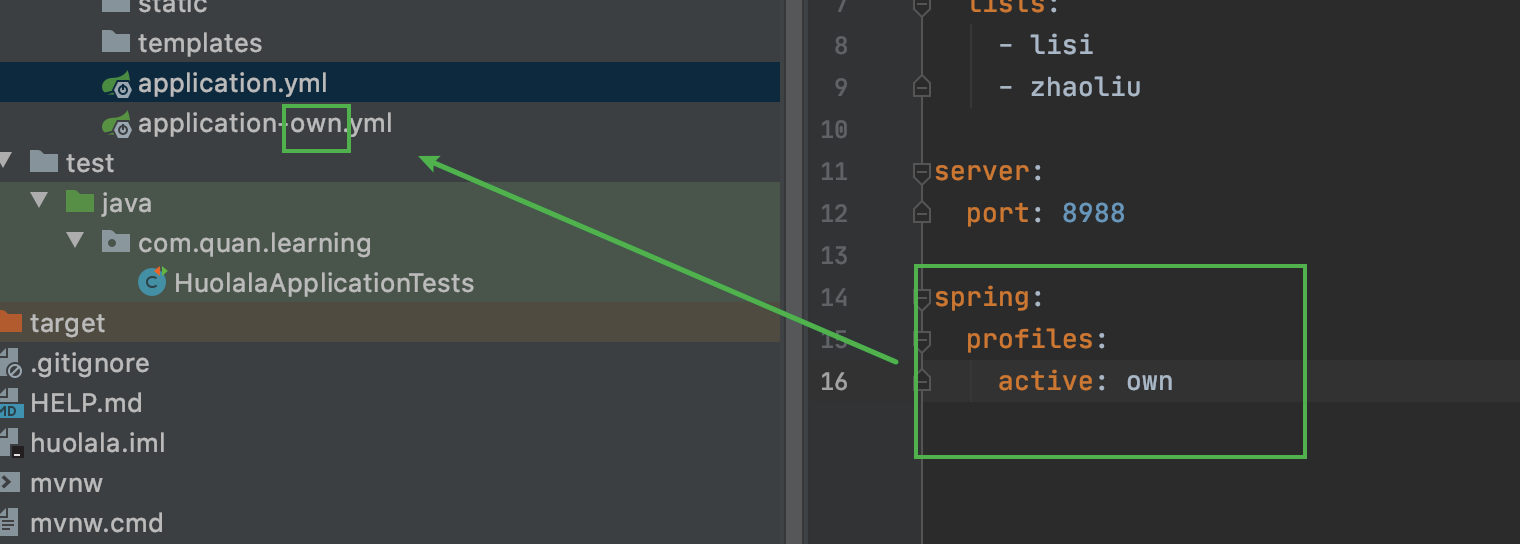
要在默认的配置文件中加入激活的配置文件才能进行知道。
也可以使用yml的多文档块模式,不用写多个配置文件
yml支持多文档块方式

server:
port: 8081
spring:
profiles:
active: prod ---
server:
port: 8083
spring:
profiles: dev --- server:
port: 8084
spring:
profiles: prod #指定属于哪个环境

---三个横线就是代表不同的配置内容分块,active:就是要激活的配置块

JVM参数的设置如下 VM options
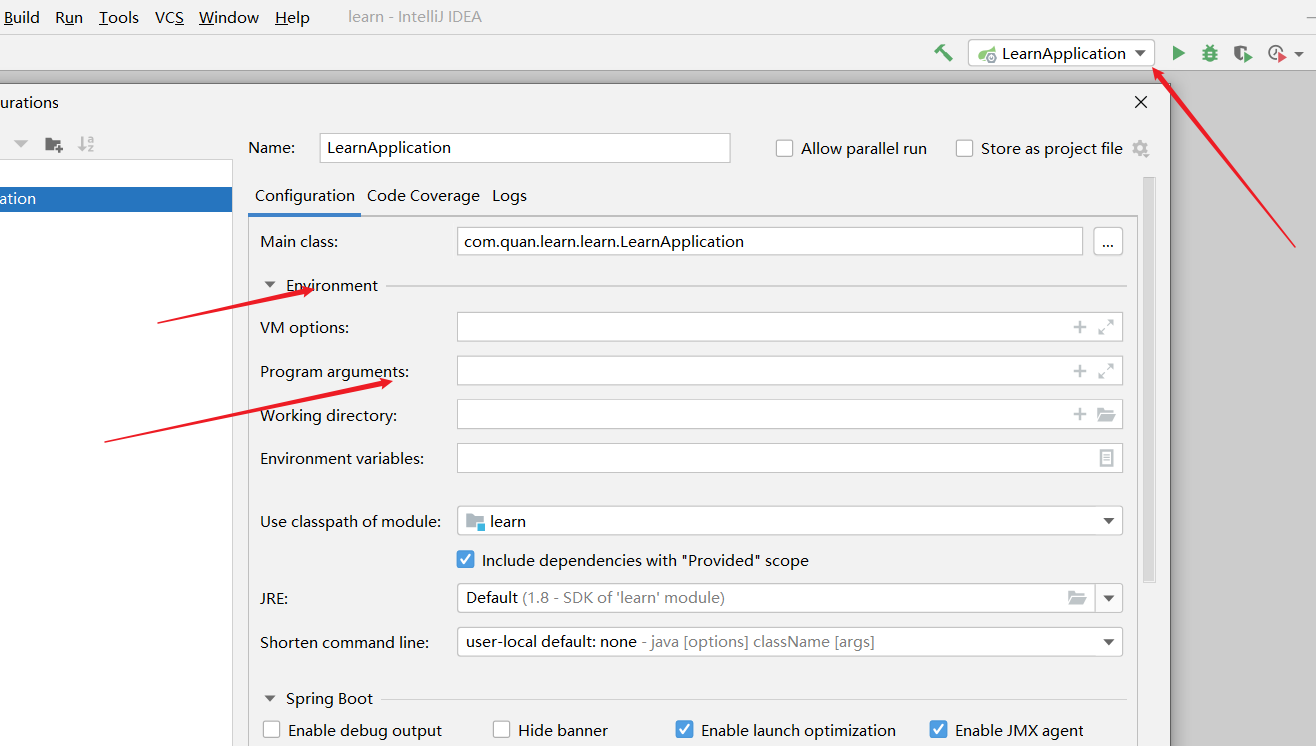
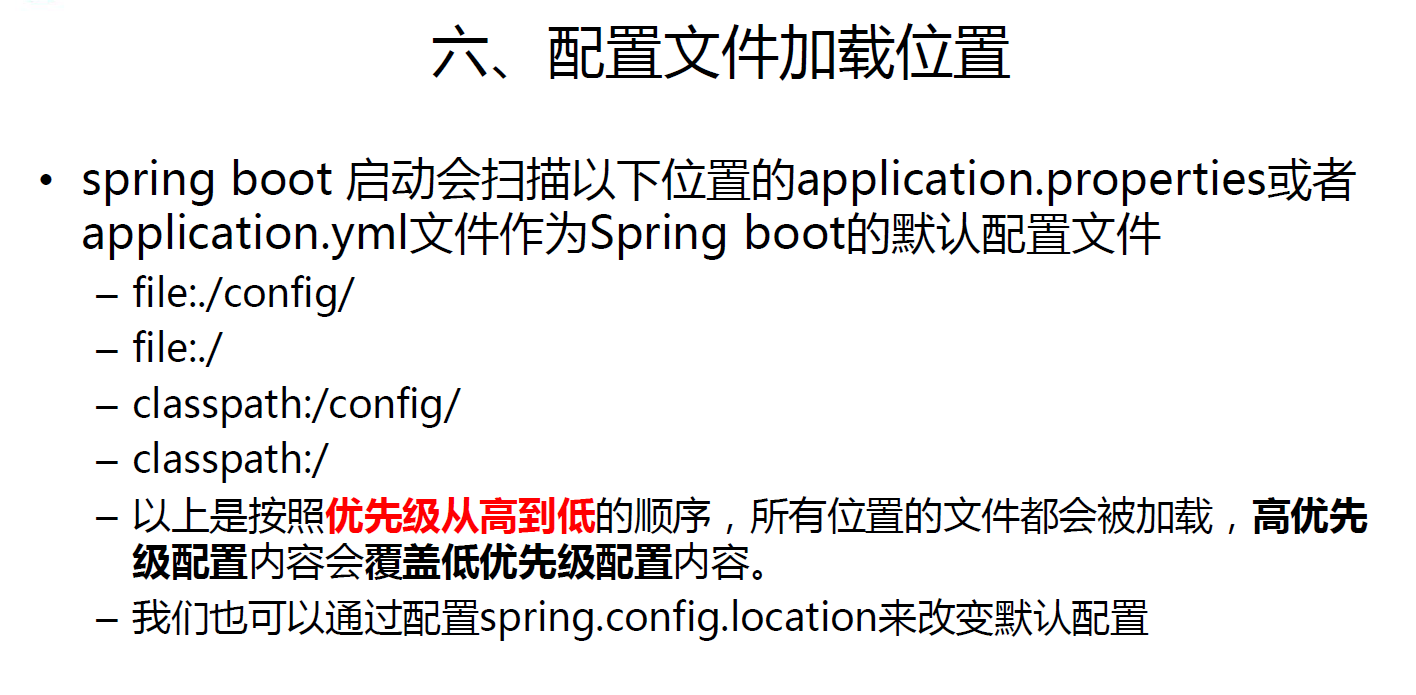
1、config/application.properties(项目根目录中config目录下)
2、config/application.yml
3、application.properties(项目根目录下)
4、application.yml
5、resources/config/application.properties(项目resources目录中config目录下)
6、resources/config/application.yml
7、resources/application.properties(项目的resources目录下)
8、resources/application.yml
配置文件的生效顺序,会对值进行覆盖
注意: SpringBoot会从这四个位置全部加载主配置文件;互补配置;
**项目打包好以后,我们可以使用命令行参数的形式,启动项目的时候来指定配置文件的新位置;
指定配置文件和默认加载的这些配置文件共同起作用形成互补配置;** java -jar spring-boot-02-config-02-0.0.1-SNAPSHOT.jar
--spring.config.location=G:/application.properties
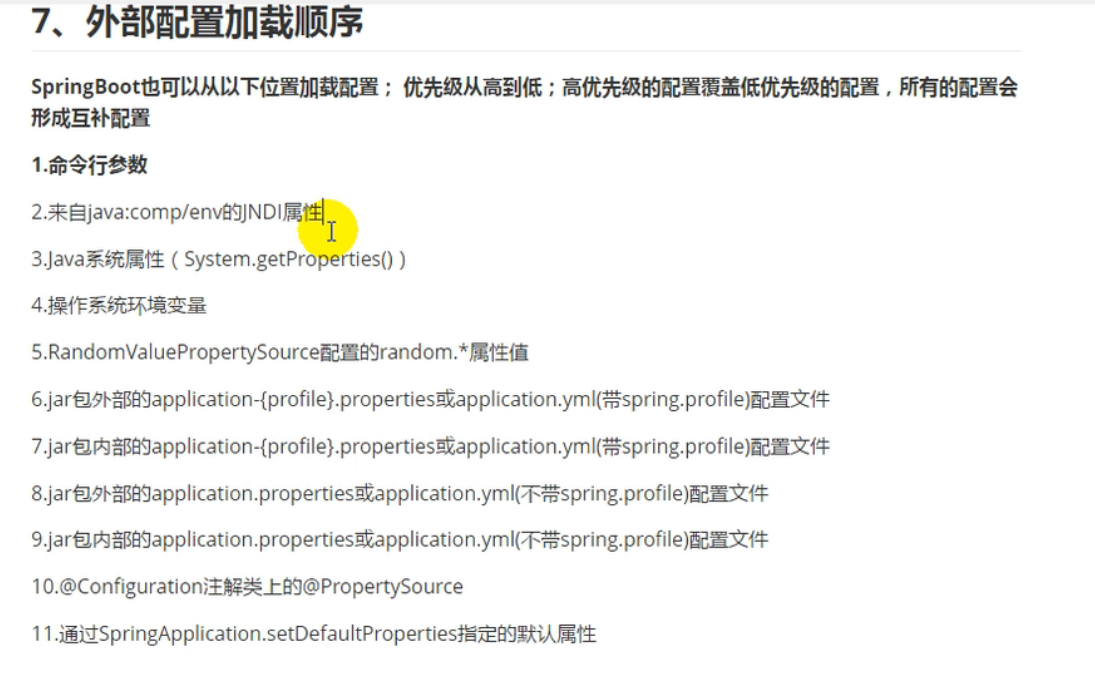
直接在命令行去配置端口
jar --jfijeifjie --server.port= 8089 命令行
自动配置原理:
SpringBoot启动的时候加载主配置类,开启了自动配置功能 ==@EnableAutoConfiguration==
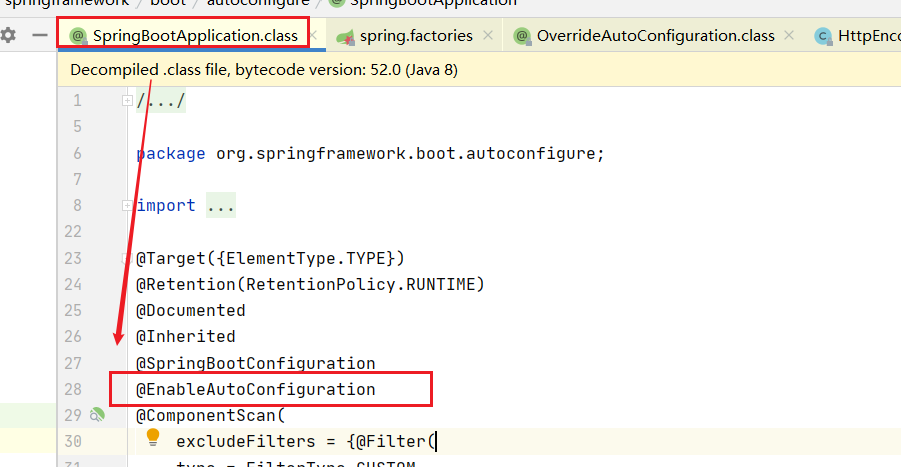
@EnableAutoConfiguration 作用:
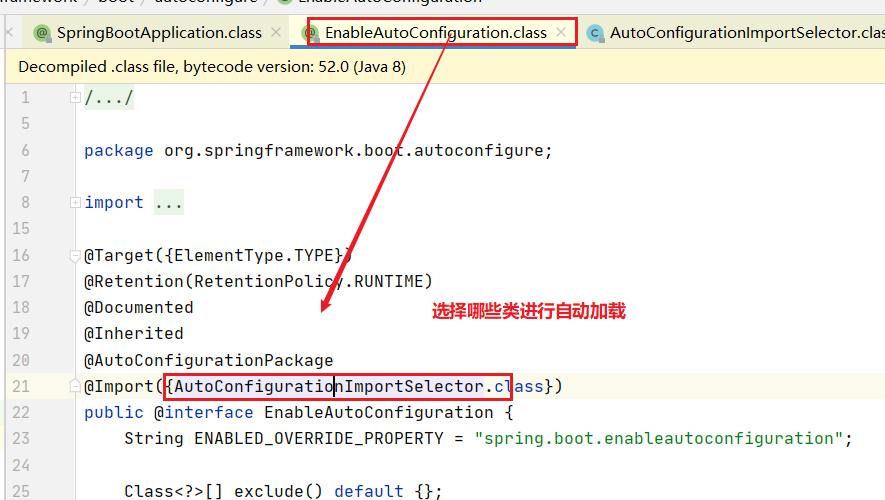
导入的AutoConfigurationImportSelector的selectImports()方法通过SpringFactoriesLoader.loadFactoryNames()扫描所有具有META-INF/spring.factories的jar包
通过selectImport方法进行选择加载

public String[] selectImports(AnnotationMetadata annotationMetadata) {
if (!this.isEnabled(annotationMetadata)) {
return NO_IMPORTS;
} else {
AutoConfigurationImportSelector.AutoConfigurationEntry autoConfigurationEntry = this.getAutoConfigurationEntry(annotationMetadata);
return StringUtils.toStringArray(autoConfigurationEntry.getConfigurations());
}
}

List<String> configurations = getCandidateConfigurations(annotationMetadata, attributes);获取候选的配置
protected List<String> getCandidateConfigurations(AnnotationMetadata metadata, AnnotationAttributes attributes) {
List<String> configurations = SpringFactoriesLoader.loadFactoryNames(this.getSpringFactoriesLoaderFactoryClass(), this.getBeanClassLoader());
Assert.notEmpty(configurations, "No auto configuration classes found in META-INF/spring.factories. If you are using a custom packaging, make sure that file is correct.");
return configurations;
}
SpringFactoriesLoader.loadFactoryNames()
扫描所有jar包类路径下 META-INF/spring.factories
把扫描到的这些文件的内容包装成properties对象
从properties中获取到EnableAutoConfiguration.class类(类名)对应的值,然后把他们添加在容器中
==将 类路径下 META-INF/spring.factories 里面配置的所有EnableAutoConfiguration的值加入到了容器中;==


# PropertySource Loaders
org.springframework.boot.env.PropertySourceLoader=\
org.springframework.boot.env.PropertiesPropertySourceLoader,\
org.springframework.boot.env.YamlPropertySourceLoader # Run Listeners
org.springframework.boot.SpringApplicationRunListener=\
org.springframework.boot.context.event.EventPublishingRunListener # Error Reporters
org.springframework.boot.SpringBootExceptionReporter=\
org.springframework.boot.diagnostics.FailureAnalyzers # Application Context Initializers
org.springframework.context.ApplicationContextInitializer=\
org.springframework.boot.context.ConfigurationWarningsApplicationContextInitializer,\
org.springframework.boot.context.ContextIdApplicationContextInitializer,\
org.springframework.boot.context.config.DelegatingApplicationContextInitializer,\
org.springframework.boot.rsocket.context.RSocketPortInfoApplicationContextInitializer,\
org.springframework.boot.web.context.ServerPortInfoApplicationContextInitializer # Application Listeners
org.springframework.context.ApplicationListener=\
org.springframework.boot.ClearCachesApplicationListener,\
org.springframework.boot.builder.ParentContextCloserApplicationListener,\
org.springframework.boot.cloud.CloudFoundryVcapEnvironmentPostProcessor,\
org.springframework.boot.context.FileEncodingApplicationListener,\
org.springframework.boot.context.config.AnsiOutputApplicationListener,\
org.springframework.boot.context.config.ConfigFileApplicationListener,\
org.springframework.boot.context.config.DelegatingApplicationListener,\
org.springframework.boot.context.logging.ClasspathLoggingApplicationListener,\
org.springframework.boot.context.logging.LoggingApplicationListener,\
org.springframework.boot.liquibase.LiquibaseServiceLocatorApplicationListener # Environment Post Processors
org.springframework.boot.env.EnvironmentPostProcessor=\
org.springframework.boot.cloud.CloudFoundryVcapEnvironmentPostProcessor,\
org.springframework.boot.env.SpringApplicationJsonEnvironmentPostProcessor,\
org.springframework.boot.env.SystemEnvironmentPropertySourceEnvironmentPostProcessor,\
org.springframework.boot.reactor.DebugAgentEnvironmentPostProcessor # Failure Analyzers
org.springframework.boot.diagnostics.FailureAnalyzer=\
org.springframework.boot.diagnostics.analyzer.BeanCurrentlyInCreationFailureAnalyzer,\
org.springframework.boot.diagnostics.analyzer.BeanDefinitionOverrideFailureAnalyzer,\
org.springframework.boot.diagnostics.analyzer.BeanNotOfRequiredTypeFailureAnalyzer,\
org.springframework.boot.diagnostics.analyzer.BindFailureAnalyzer,\
org.springframework.boot.diagnostics.analyzer.BindValidationFailureAnalyzer,\
org.springframework.boot.diagnostics.analyzer.UnboundConfigurationPropertyFailureAnalyzer,\
org.springframework.boot.diagnostics.analyzer.ConnectorStartFailureAnalyzer,\
org.springframework.boot.diagnostics.analyzer.NoSuchMethodFailureAnalyzer,\
org.springframework.boot.diagnostics.analyzer.NoUniqueBeanDefinitionFailureAnalyzer,\
org.springframework.boot.diagnostics.analyzer.PortInUseFailureAnalyzer,\
org.springframework.boot.diagnostics.analyzer.ValidationExceptionFailureAnalyzer,\
org.springframework.boot.diagnostics.analyzer.InvalidConfigurationPropertyNameFailureAnalyzer,\
org.springframework.boot.diagnostics.analyzer.InvalidConfigurationPropertyValueFailureAnalyzer # FailureAnalysisReporters
org.springframework.boot.diagnostics.FailureAnalysisReporter=\
org.springframework.boot.diagnostics.LoggingFailureAnalysisReporter

每一个这样的 xxxAutoConfiguration类都是容器中的一个组件,都加入到容器中;用他们来做自动配置;
#############################
每一个自动配置类进行自动配置功能;
以HttpEncodingAutoConfiguration(Http编码自动配置)为例解释自动配置原理;

//表示这是一个配置类,以前编写的配置文件一样,也可以给容器中添加组件
@Configuration(proxyBeanMethods = false)
//启动指定类的ConfigurationProperties功能;将配置文件中对应的值和ServerProperties绑定起来;
//并把ServerProperties加入到ioc容器中
@EnableConfigurationProperties({ServerProperties.class})
/Spring底层@Conditional注解(Spring注解版),根据不同的条件,如果满足指定的条件,整个配置类里面的配置
就会生效; 判断当前应用是否是web应用,如果是,当前配置类生效
@ConditionalOnWebApplication(type = Type.SERVLET)
//判断当前项目有没有这个类CharacterEncodingFilter;SpringMVC中进行乱码解决的过滤器;
@ConditionalOnClass({CharacterEncodingFilter.class})
//判断配置文件中是否存在某个配置 spring.servlet.enabled;如果不存在,判断也是成立的
//即使我们配置文件中不配置spring.servlet.encoding.enabled=true,也是默认生效的;
@ConditionalOnProperty(
prefix = "server.servlet.encoding",
value = {"enabled"},
matchIfMissing = true
)
public class HttpEncodingAutoConfiguration {
//他已经和SpringBoot的配置文件映射了
private final Encoding properties;
//只有一个有参构造器的情况下,参数的值就会从容器中拿
public HttpEncodingAutoConfiguration(ServerProperties properties) {
this.properties = properties.getServlet().getEncoding();
}
@Bean //给容器中添加一个组件filter,这个组件的某些值需要从properties中获取
//@ConditionnalOnMissingBean判断容器没有这个组件?
@ConditionalOnMissingBean
public CharacterEncodingFilter characterEncodingFilter() {
CharacterEncodingFilter filter = new OrderedCharacterEncodingFilter();
filter.setEncoding(this.properties.getCharset().name());
filter.setForceRequestEncoding(this.properties.shouldForce(org.springframework.boot.web.servlet.server.Encoding.Type.REQUEST));
filter.setForceResponseEncoding(this.properties.shouldForce(org.springframework.boot.web.servlet.server.Encoding.Type.RESPONSE));
return filter;
}

根据当前不同的条件判断,决定这个配置类是否生效?
一但这个配置类生效;这个配置类就会给容器中添加各种组件;这些组件的属性是从对应的properties类中获取的,这些类里面的每一个属性又是和配置文件绑定的;
所有在配置文件中能配置的属性都是在xxxxProperties类中封装者‘;配置文件能配置什么就可以参照某个
功能对应的这个属性类
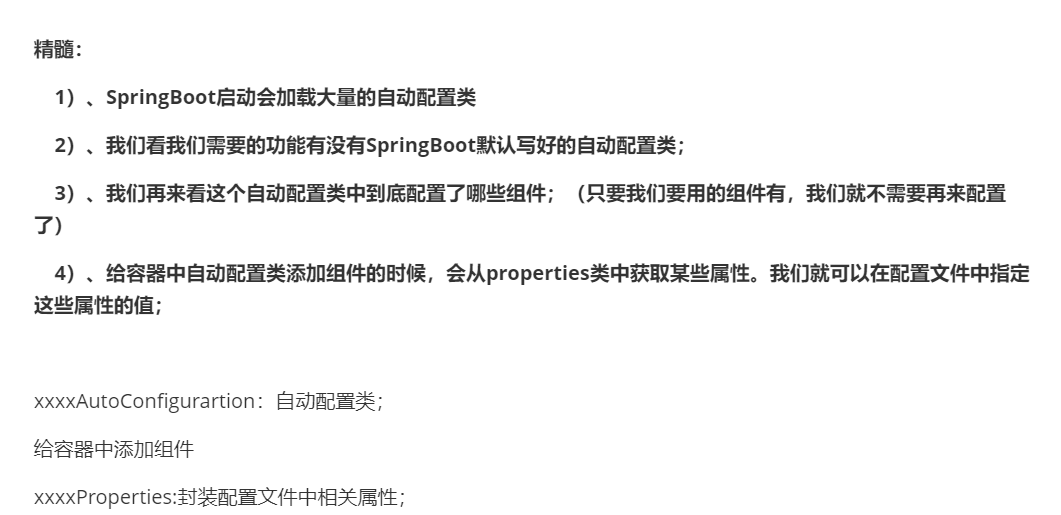
@Conditional派生注解(Spring注解版原生的@Conditional作用)
作用:必须是@Conditional指定的条件成立,才给容器中添加组件,配置配里面的所有内容才生效;
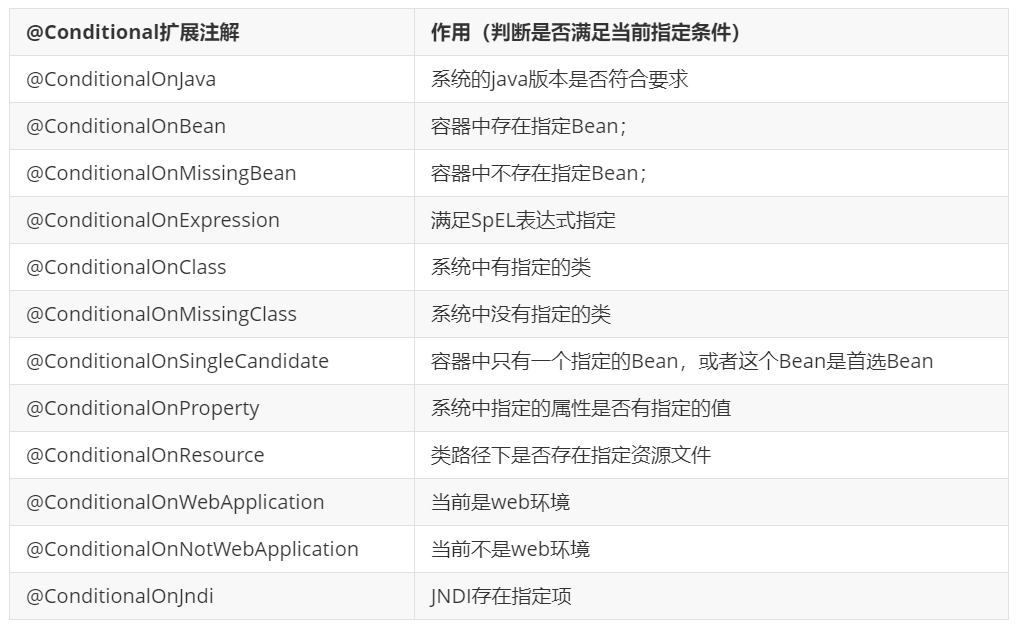
注意:自动配置类必须在一定的条件下才能生效;
怎么才能知道呢
==我们可以通过启用 debug=true属性;来让控制台打印自动配置报告==,这样我们就可以很方便的知道哪些自动配置类生效;


============================
CONDITIONS EVALUATION REPORT
============================ Positive matches: //自动加载启用的配置累
----------------- AopAutoConfiguration matched:
- @ConditionalOnProperty (spring.aop.auto=true) matched (OnPropertyCondition) AopAutoConfiguration.ClassProxyingConfiguration matched:
- @ConditionalOnMissingClass did not find unwanted class 'org.aspectj.weaver.Advice' (OnClassCondition)
- @ConditionalOnProperty (spring.aop.proxy-target-class=true) matched (OnPropertyCondition) DispatcherServletAutoConfiguration matched:
- @ConditionalOnClass found required class 'org.springframework.web


Negative matches:自动加载不启用,不满足condition条件的
----------------- ActiveMQAutoConfiguration:
Did not match:
- @ConditionalOnClass did not find required class 'javax.jms.ConnectionFactory' (OnClassCondition) AopAutoConfiguration.AspectJAutoProxyingConfiguration:
Did not match:
- @ConditionalOnClass did not find required class 'org.aspectj.weaver.Advice' (OnClassCondition)

spring-boot-learning-配置文件相关的更多相关文章
- Spring Boot 的配置文件application.properties
Spring Boot 中的application.properties 是一个全局的配置文件,放在src/main/resources 目录下或者类路径的/config下. 作为全局配置文件的app ...
- Spring Boot之配置文件值注入(@ConfigurationProperties)
前言:Spring Boot配置文件值的注入有两种方式,分别是 @ConfigurationProperties @Value 这里我们使用第一种 首先我们创建一个application.yml文件, ...
- 一:Spring Boot 的配置文件 application.properties
Spring Boot 的配置文件 application.properties 1.位置问题 2.普通的属性注入 3.类型安全的属性注入 1.位置问题 当我们创建一个 Spring Boot 工程时 ...
- 精进 Spring Boot 03:Spring Boot 的配置文件和配置管理,以及用三种方式读取配置文件
精进 Spring Boot 03:Spring Boot 的配置文件和配置管理,以及用三种方式读取配置文件 内容简介:本文介绍 Spring Boot 的配置文件和配置管理,以及介绍了三种读取配置文 ...
- Spring Boot(二) 配置文件
文章导航-readme 一.配置Spring Boot热部署 技术的发展总是因为人们想偷懒的心理,如果我们不想每次修改了代码,都必须重启一下服务器,并重新运行代码.那么可以配置一下热部署.有了 ...
- Spring Boot属性配置文件:application.properties 详解
学习资料 网址 官方说明文档 https://docs.spring.io/spring-boot/docs/current/reference/html/common-application-pro ...
- Spring Boot 核心配置文件 bootstrap & application
Spring Boot 核心配置文件 bootstrap & application 1.SpringBoot bootstrap配置文件不生效问题 2.bootstrap/ applicat ...
- spring boot全局配置文件优先级
前两篇介绍的application配置文件,即为spring boot全局配置文件.那么spring boot加载配置文件的时候,怎么确定加载哪个目录下哪个文件呢? spring boot默认的配置文 ...
- spring boot项目配置文件集合
表 1. Spring Boot 推荐的基础 POM 文件 名称 说明 spring-boot-starter 核心 POM,包含自动配置支持.日志库和对 YAML 配置文件的支持. spring-b ...
- Spring Boot属性配置文件详解
相信很多人选择Spring Boot主要是考虑到它既能兼顾Spring的强大功能,还能实现快速开发的便捷.我们在Spring Boot使用过程中,最直观的感受就是没有了原来自己整合Spring应用时繁 ...
随机推荐
- DoS,DDoS,DRoS攻击
- k8s初面考点ReplicaSet副本集极限9连击你懂了吗?
k8s初面考点ReplicaSet副本集极限9连击你懂了吗? k8s考点灵魂拷问9连击 考点之简单描述一下k8s副本集ReplicaSet有什么作用? 考点之为什么ReplicaSet将取代Repli ...
- 《Symfony 5全面开发》教程05、http请求的query参数
首先我们删除上节课所下的断点,在Phpstorm底部我们打开debug选项卡.点击这个按钮展开所有的PHP断点,选中之后点击这个删除,然后我们关闭xdebug监听. 回到浏览器刷新页面,当我们的浏览器 ...
- Codeforces Round #770 (Div. 2)D
传送门 题目大意: 交互题, n ( 4 ≤ n ≤ 1000 ) n(4\leq n\leq1000) n(4≤n≤1000)个数字组成的数列 a 1 , a 2 , - , a n ( 0 ≤ a ...
- Python:格式化字符串的几种方式
1.% 'abc%s'%'123' 'abc123' 'abc%s%s'%('123','456') 'abc123456' 当变量v是一个Tuple.List且其中元素数量和字符串中%数量相同时,可 ...
- KETTLE使用中的错误集锦
1.违反唯一主键约束条件:问题是表中有俩个主键,将备用主键替换成真正的主 键或者是没有对数据做出处理加这句话and cft.DEL_FLAG!='1'或者要到的库有此数据 2.field 某列 is ...
- deepin 字符集安装
deepin字符集安装 编辑 目录介绍 /usr/share/i18n/charmaps 这个目录下存放了该Linux操作系统可用字符集的安装包,如果你的操作系统上没有安装某个字符集可以到这个目录下寻 ...
- 矩池云助力科研算力免费上"云",让 AI 教学简单起来
矩池云是一个专业的国内深度学习云平台,拥有着良好的深度学习云端训练体验,和高性价比的GPU集群资源.而且对同学们比较友好,会经常做一些大折扣的活动,最近双十一,全场所有的RTX 2070.Platin ...
- CLR的GC工作模式介绍(Workstation和Server)
CLR的核心功能之一就是垃圾回收(garbage collection),关于GC的基本概念本文不在赘述.这里主要针对GC的两种工作模式展开讨论和研究. Workstaction模式介绍 该模式设计的 ...
- Linux-本地日志服务管理(rsyslog基础)
目录 系统环境 1.常见的两种日志管理服务 1.1 RSYSLOG系统日志服务 1.2 ELK 2.RSYSLOG日志服务的相关知识 2.1 RSYSLOG日志消息级别 2.2 RSYSLOG日志服务 ...
